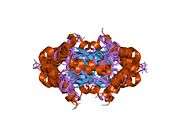UBE2B
Ubiquitin-conjugating enzyme E2 B is a protein that in humans is encoded by the UBE2B gene.[5][6]
The modification of proteins with ubiquitin is an important cellular mechanism for targeting abnormal or short-lived proteins for degradation. Ubiquitination involves at least three classes of enzymes: ubiquitin-activating enzymes, or E1s, ubiquitin-conjugating enzymes, or E2s, and ubiquitin-protein ligases, or E3s. This gene encodes a member of the E2 ubiquitin-conjugating enzyme family. This enzyme is required for post-replicative DNA damage repair. Its protein sequence is 100% identical to the mouse, rat, and rabbit homologs, which indicates that this enzyme is highly conserved in eukaryotic evolution.[6]
Interactions
References
- 1 2 3 GRCh38: Ensembl release 89: ENSG00000119048 - Ensembl, May 2017
- 1 2 3 GRCm38: Ensembl release 89: ENSMUSG00000020390 - Ensembl, May 2017
- ↑ "Human PubMed Reference:".
- ↑ "Mouse PubMed Reference:".
- ↑ Koken MH, Smit EM, Jaspers-Dekker I, Oostra BA, Hagemeijer A, Bootsma D, Hoeijmakers JH (May 1992). "Localization of two human homologs, HHR6A and HHR6B, of the yeast DNA repair gene RAD6 to chromosomes Xq24-q25 and 5q23-q31". Genomics. 12 (3): 447–53. doi:10.1016/0888-7543(92)90433-S. PMID 1559696.
- 1 2 "Entrez Gene: UBE2B ubiquitin-conjugating enzyme E2B (RAD6 homolog)".
- ↑ Xin, H; Lin W; Sumanasekera W; Zhang Y; Wu X; Wang Z (July 2000). "The human RAD18 gene product interacts with HHR6A and HHR6B". Nucleic Acids Res. ENGLAND. 28 (14): 2847–54. doi:10.1093/nar/28.14.2847. PMC 102657. PMID 10908344.
- ↑ Tateishi, S; Sakuraba Y; Masuyama S; Inoue H; Yamaizumi M (July 2000). "Dysfunction of human Rad18 results in defective postreplication repair and hypersensitivity to multiple mutagens". Proc. Natl. Acad. Sci. U.S.A. UNITED STATES. 97 (14): 7927–32. Bibcode:2000PNAS...97.7927T. doi:10.1073/pnas.97.14.7927. ISSN 0027-8424. PMC 16647. PMID 10884424.
Further reading
- Koken MH, Reynolds P, Jaspers-Dekker I, et al. (1991). "Structural and functional conservation of two human homologs of the yeast DNA repair gene RAD6". Proc. Natl. Acad. Sci. U.S.A. 88 (20): 8865–9. Bibcode:1991PNAS...88.8865K. doi:10.1073/pnas.88.20.8865. PMC 52611. PMID 1717990.
- Woffendin C, Chen ZY, Staskus K, et al. (1991). "Mammalian mRNAs encoding protein closely related to ubiquitin-conjugating enzyme encoded by yeast DNA repair gene RAD6". Biochim. Biophys. Acta. 1090 (1): 81–5. doi:10.1016/0167-4781(91)90039-o. PMID 1883845.
- Schneider R, Eckerskorn C, Lottspeich F, Schweiger M (1990). "The human ubiquitin carrier protein E2(Mr = 17,000) is homologous to the yeast DNA repair gene RAD6". EMBO J. 9 (5): 1431–5. PMC 551831. PMID 2158443.
- Koken MH, Hoogerbrugge JW, Jasper-Dekker I, et al. (1996). "Expression of the ubiquitin-conjugating DNA repair enzymes HHR6A and B suggests a role in spermatogenesis and chromatin modification". Dev. Biol. 173 (1): 119–32. doi:10.1006/dbio.1996.0011. PMID 8575614.
- Tateishi S, Sakuraba Y, Masuyama S, et al. (2000). "Dysfunction of human Rad18 results in defective postreplication repair and hypersensitivity to multiple mutagens". Proc. Natl. Acad. Sci. U.S.A. 97 (14): 7927–32. Bibcode:2000PNAS...97.7927T. doi:10.1073/pnas.97.14.7927. PMC 16647. PMID 10884424.
- Xin H, Lin W, Sumanasekera W, et al. (2000). "The human RAD18 gene product interacts with HHR6A and HHR6B". Nucleic Acids Res. 28 (14): 2847–54. doi:10.1093/nar/28.14.2847. PMC 102657. PMID 10908344.
- Miura T, Klaus W, Ross A, et al. (2003). "The NMR structure of the class I human ubiquitin-conjugating enzyme 2b". J. Biomol. NMR. 22 (1): 89–92. doi:10.1023/A:1013807519703. PMID 11885984.
- Shekhar MP, Lyakhovich A, Visscher DW, et al. (2002). "Rad6 overexpression induces multinucleation, centrosome amplification, abnormal mitosis, aneuploidy, and transformation". Cancer Res. 62 (7): 2115–24. PMID 11929833.
- Strausberg RL, Feingold EA, Grouse LH, et al. (2003). "Generation and initial analysis of more than 15,000 full-length human and mouse cDNA sequences". Proc. Natl. Acad. Sci. U.S.A. 99 (26): 16899–903. Bibcode:2002PNAS...9916899M. doi:10.1073/pnas.242603899. PMC 139241. PMID 12477932.
- Kwon YT, Xia Z, An JY, et al. (2003). "Female lethality and apoptosis of spermatocytes in mice lacking the UBR2 ubiquitin ligase of the N-end rule pathway". Mol. Cell. Biol. 23 (22): 8255–71. doi:10.1128/MCB.23.22.8255-8271.2003. PMC 262401. PMID 14585983.
- Lyakhovich A, Shekhar MP (2004). "RAD6B overexpression confers chemoresistance: RAD6 expression during cell cycle and its redistribution to chromatin during DNA damage-induced response". Oncogene. 23 (17): 3097–106. doi:10.1038/sj.onc.1207449. PMID 14981545.
- Watanabe K, Tateishi S, Kawasuji M, et al. (2005). "Rad18 guides poleta to replication stalling sites through physical interaction and PCNA monoubiquitination". EMBO J. 23 (19): 3886–96. doi:10.1038/sj.emboj.7600383. PMC 522788. PMID 15359278.
- Gerhard DS, Wagner L, Feingold EA, et al. (2004). "The status, quality, and expansion of the NIH full-length cDNA project: the Mammalian Gene Collection (MGC)". Genome Res. 14 (10B): 2121–7. doi:10.1101/gr.2596504. PMC 528928. PMID 15489334.
- Stelzl U, Worm U, Lalowski M, et al. (2005). "A human protein-protein interaction network: a resource for annotating the proteome". Cell. 122 (6): 957–68. doi:10.1016/j.cell.2005.08.029. PMID 16169070.
- Shekhar MP, Tait L, Gerard B (2007). "Essential role of T-cell factor/beta-catenin in regulation of Rad6B: a potential mechanism for Rad6B overexpression in breast cancer cells". Mol. Cancer Res. 4 (10): 729–45. doi:10.1158/1541-7786.MCR-06-0136. PMID 17050667.
This article is issued from
Wikipedia.
The text is licensed under Creative Commons - Attribution - Sharealike.
Additional terms may apply for the media files.








